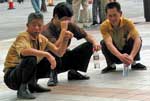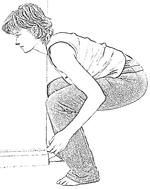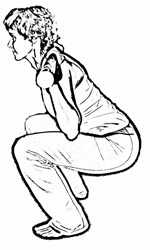Squatting and the knees
It is common knowledge that when doing squats the knees should stay behind the toes in order to prevent knee problems. At least that is the knowledge that has permeated the fitness industry. Is this true?
 Squatting is the movement we do when we sit down on a chair and get back up again. In many parts of the world, squatting right to the floor is common practice. People may squat while cooking over a fire, while reading the newspaper, or while using a squat toilet. In my opinion, squatting to the floor regularly is very helpful in maintaining happy hips, knees and ankles.
Squatting is the movement we do when we sit down on a chair and get back up again. In many parts of the world, squatting right to the floor is common practice. People may squat while cooking over a fire, while reading the newspaper, or while using a squat toilet. In my opinion, squatting to the floor regularly is very helpful in maintaining happy hips, knees and ankles.
In the gym when we squat, we sit down momentarily on an imaginary chair, and when our thighs are about parallel to the floor we stand up again. Squats are one of the key movements exercise professionals teach their clients, and they are fantastic for strengthening the lower body.
I have been in the fitness industry for close to 20 years now, and I can’t count the number of times I’ve heard that when squatting one must keep the knees behind the toes in order to protect the knees. This rule is very ingrained in the psyche of personal trainers as I have heard the line repeated frequently in the gym. And in the past, I too have tried to shape my clients’ squats to follow the “knees behind the toes” adage, with very unsatisfactory results.
Most people’s lower legs are too long to keep the knees behind the toes even when one limits the range-of-motion to thighs parallel to the ground. This instruction forces strange movement patterns that are awkward and incorrect in my opinion.
 The "knees behind the toes" requirement fixes the angle at the ankle; the longer the lower leg, the higher the ankle angle. This forces the hips very far back, and to avoid falling over, the only way to compensate is to bend the hip joint much more than usual in order to get the center of gravity back over the feet again. This movement looks more like a deadlift (bend) than a squat. In the diagram to the right, the foot and knee are butted up against a wall, and one can easily see how there is far more bend at the hips than at the knee and ankle. The spine is at a much flatter angle than the lower leg.
The "knees behind the toes" requirement fixes the angle at the ankle; the longer the lower leg, the higher the ankle angle. This forces the hips very far back, and to avoid falling over, the only way to compensate is to bend the hip joint much more than usual in order to get the center of gravity back over the feet again. This movement looks more like a deadlift (bend) than a squat. In the diagram to the right, the foot and knee are butted up against a wall, and one can easily see how there is far more bend at the hips than at the knee and ankle. The spine is at a much flatter angle than the lower leg.
The other common compensation is to actively arch the back a great deal, which can irritate the facet joints and over-use the erector spinae muscles in the back. The spine should remain neutral for most of the range of motion. If one is squatting to the floor, the low back will probably round at the bottom unless one is extremely flexible. (*Squatting to the floor is fine with no weight, but if you are carrying extra weight, only squat as deeply as you can keep your spine neutral. A rounded low-back while carrying added weight is asking for trouble).
 Our knees are meant to bend to the point where the back of the thighs can easily rest on the calves. With adequate flexibility, one can kneel on the floor like this putting a fair bit of pressure through the legs without any problem. The knee joint is open, so the thigh bone (femur) and lower-leg bone (tibia) are not rubbing on each other at all in this position. Any strain in the knee area would come from tight muscles, tendons, and fascia. Flexibility is the limiting factor in this case, and that can be slowly improved over time. The limits put on a squat should be determined by one’s own flexibility rather than an arbitrary rule like “knees must stay behind the toes”.
Our knees are meant to bend to the point where the back of the thighs can easily rest on the calves. With adequate flexibility, one can kneel on the floor like this putting a fair bit of pressure through the legs without any problem. The knee joint is open, so the thigh bone (femur) and lower-leg bone (tibia) are not rubbing on each other at all in this position. Any strain in the knee area would come from tight muscles, tendons, and fascia. Flexibility is the limiting factor in this case, and that can be slowly improved over time. The limits put on a squat should be determined by one’s own flexibility rather than an arbitrary rule like “knees must stay behind the toes”.
 Olympic lifters regularly pass through the front squat position with a very heavy bar, and their knees are often past their toes. They have the flexibility in their legs and back to be able to do the movement without a problem.
Olympic lifters regularly pass through the front squat position with a very heavy bar, and their knees are often past their toes. They have the flexibility in their legs and back to be able to do the movement without a problem.
 One should think of squatting like folding up an accordion. One stays over the center of gravity (the feet), the knees hinge forward tracking over the toes, the hips hinge back, the trunk goes forward again. The spine parallels the shin angle, remains neutral, and is not contorted at all since the hinge is at the hips. This is what we naturally do when we sit down and get up from a chair, so this is the best place to begin a squatting practice.
One should think of squatting like folding up an accordion. One stays over the center of gravity (the feet), the knees hinge forward tracking over the toes, the hips hinge back, the trunk goes forward again. The spine parallels the shin angle, remains neutral, and is not contorted at all since the hinge is at the hips. This is what we naturally do when we sit down and get up from a chair, so this is the best place to begin a squatting practice.
I find I now often use the cue “knees and nose in front of the toes” when teaching unweighted or back squats, and when the center of gravity is balanced throughout the entire foot the result is usually a fine squat with no deviation from neutral spine – exactly what I’m looking for. I stop their descent just before their low back begins to round, and have them push back up through the whole of their feet.
If you want to share this article, scroll to the very bottom and click the “share” icon to post on Facebook, Twitter etc. If you want to subscribe or search for other posts by title or by topic, go to www.wellnesstips.ca.
Related tips:
How many ways can you get up from the floor?
10 body positions we should all find relaxing
Poliquin, Charles 8 stupid myths about squatting Blog www.CharlesPoliquin.com
Copyright 2011 Vreni Gurd
 Facebook Wellness-Tips Page
Facebook Wellness-Tips Page
Doug said,
March 21, 2011 @ 9:17 am
Good points Vreni,
I try to emphasis that while squatting, you try and keep your ear in line with your ankle. Most of my clients find this helpful.
Keep up the great work!
open patella knee brace said,
May 18, 2016 @ 8:52 pm
Hi! Would you mind if I share your blog with my facebook group?
There’s a lot of people that I think would really appreciate your content.
Please let me know. Thanks